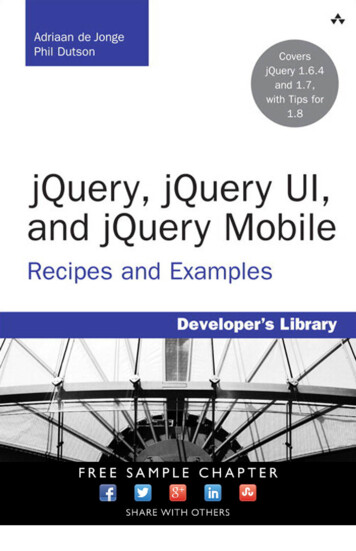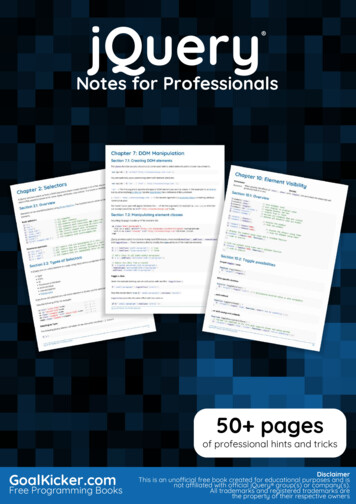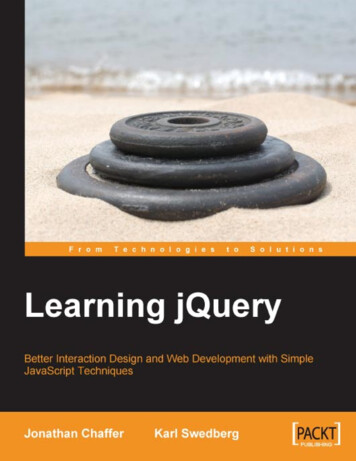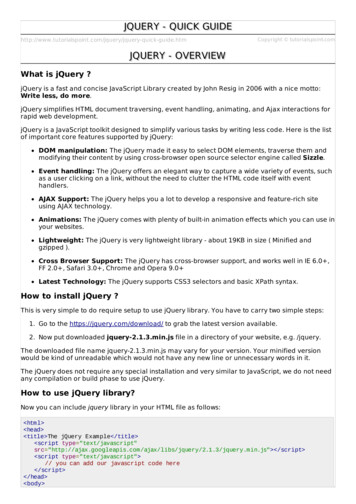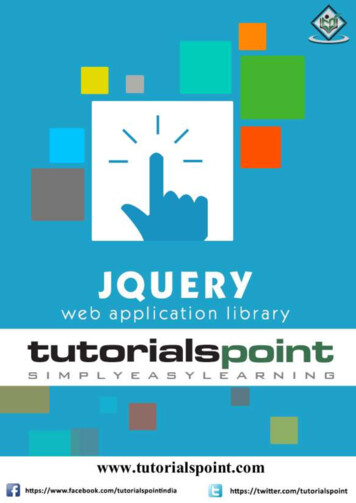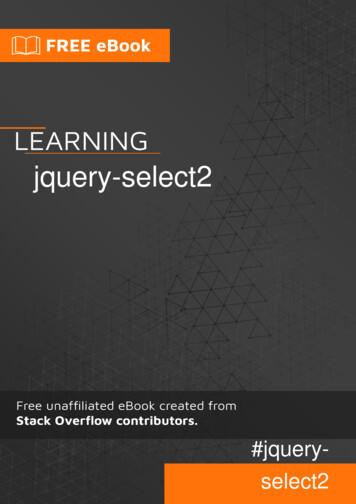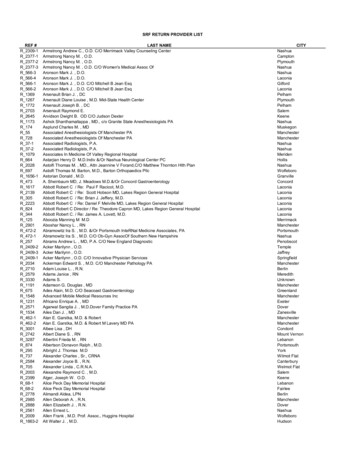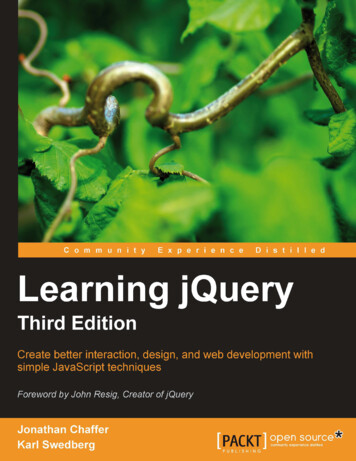
Transcription
Learning jQueryThird EditionCreate better interaction, design, and web developmentwith simple JavaScript techniquesJonathan ChafferKarl SwedbergBIRMINGHAM - MUMBAI
Learning jQueryThird EditionCopyright 2011 Packt PublishingAll rights reserved. No part of this book may be reproduced, stored in a retrievalsystem, or transmitted in any form or by any means, without the prior writtenpermission of the publisher, except in the case of brief quotations embedded incritical articles or reviews.Every effort has been made in the preparation of this book to ensure the accuracyof the information presented. However, the information contained in this book issold without warranty, either express or implied. Neither the authors, nor PacktPublishing, and its dealers and distributors will be held liable for any damagescaused or alleged to be caused directly or indirectly by this book.Packt Publishing has endeavored to provide trademark information about all of thecompanies and products mentioned in this book by the appropriate use of capitals.However, Packt Publishing cannot guarantee the accuracy of this information.First published: September 2011Production Reference: 1160911Published by Packt Publishing Ltd.Livery Place35 Livery StreetBirmingham B3 2PB, UK.ISBN 978-1-84951-654-9www.packtpub.comCover Image by Karl Swedberg (kswedberg@gmail.com)
CreditsAuthorsJonathan ChafferProofreaderLinda MorrisKarl SwedbergIndexersReviewersKaiser AhmedTejal DaruwaleRekha NairKevin BoudlocheCarlos EstebesAcquisition EditorSarah CullingtonDevelopment EditorGraphicsNilesh MohiteProduction CoordinatorsAparna BhagatPrachali BhiwandkarRoger D'souzaCover WorkTechnical EditorsLlewellyn F. RozarioAzharuddin SheikhProject CoordinatorSrimoyee GhoshalAparna BhagatPrachali Bhiwandkar
ForewordI feel honored knowing that Karl Swedberg and Jonathan Chaffer undertook the taskof writing Learning jQuery. As the first book about jQuery, it set the standard thatother jQuery—and, really, other JavaScript books in general—have tried to match.It's consistently been one of the top selling JavaScript books since its release, in nosmall part due to its quality and attention to detail.I'm especially pleased that it was Karl and Jonathan who wrote the book as I alreadyknew them so well and knew that they would be perfect for the job. Being part ofthe core jQuery team, I've had the opportunity to come to know Karl quite well overthe past couple years, and especially within the context of his book writing effort.Looking at the end result, it's clear that his skills as both a developer and a formerEnglish teacher were perfectly designed for this singular task.I've also had the opportunity to meet both of them in person, a rare occurrence inthe world of distributed Open Source projects, and they continue to be upstandingmembers of the jQuery community.The jQuery library is used by so many different people in the jQuery community.The community is full of designers, developers, people who have experienceprogramming, and those who don't. Even within the jQuery team, we have peoplefrom all backgrounds providing their feedback on the direction of the project. Thereis one thing that is common across all of jQuery's users, though: We are a communityof developers and designers who want JavaScript development to be made simple.It's almost a cliché, at this point, to say that an open source project is communityoriented, or that a project wants to focus on helping new users get started. However,it's not just an empty gesture for jQuery; it's the liquid-oxygen fuel for the project.We actually have more people in the jQuery team dedicated to managing the jQuerycommunity, writing documentation, or writing plugins than actually maintainingthe core code base. While the health of the library is incredibly important, thecommunity surrounding that code is the difference between a floundering,mediocre project and one that will match and exceed your every need.
How we run the project, and how you use the code, is fundamentally very differentfrom most open source projects—and most JavaScript libraries. The jQuery projectand community is incredibly knowledgeable; we understand what makes jQuerya different programming experience and do our best to pass that knowledge on tofellow users.The jQuery community isn't something that you can read about to understand; it'ssomething that you actually have to participate in for it to fully sink in. I hope thatyou'll have the opportunity to partake in it. Come join us in our forums, mailinglists, and blogs and let us help guide you through the experience of getting to knowjQuery better.For me, jQuery is much more than a block of code. It's the sum total of experiencesthat have transpired over the years in order to make the library happen. Theconsiderable ups and downs, the struggle of development together with theexcitement of seeing it grow and succeed. Growing close with its users and fellowteam members, understanding them and trying to grow and adapt.When I first saw this book talk about jQuery and discuss it like a unified tool, asopposed to the experiences that it's come to encapsulate for me, I was both takenaback and excited. Seeing how others learn, understand, and mold jQuery to fitthem is much of what makes the project so exhilarating.I'm not the only one who enjoys jQuery on a level that is far different from a normaltool-user relationship. I don't know if I can properly encapsulate why this is, but I'veseen it time and time again—the singular moment when a user's face lights up withthe realization of just how much jQuery will help them.There is a specific moment where it just clicks for a jQuery user, when they realizethat this tool that they were using was in fact much, much more than just a simpletool all along—and suddenly their understanding of how to write dynamic webapplications completely shifts. It's an incredible thing, and absolutely my favoritepart of the jQuery project.I hope you'll have the opportunity to experience this sensation as well.John ResigCreator of jQuery
About the AuthorsJonathan Chaffer is a member of Rapid Development Group, a web developmentfirm located in Grand Rapids, Michigan. His work there includes overseeing andimplementing projects in a wide variety of technologies, with an emphasis in PHP,MySQL, and JavaScript. He also leads on-site training seminars on the jQueryframework for web developers.In the open-source community, Jonathan has been very active in the Drupal CMSproject, which has adopted jQuery as its JavaScript framework of choice. He is thecreator of the Content Construction Kit, a popular module for managing structuredcontent on Drupal sites. He is responsible for major overhauls of Drupal's menusystem and developer API reference.Jonathan lives in Grand Rapids with his wife, Jennifer.I would like to thank Jenny for her tireless enthusiasm and support,Karl for the motivation to continue writing when the spirit is weak,and the Ars Technica community for constant inspiration towardtechnical excellence. In addition, I'd like to thank Mike Henry andthe Twisted Pixel team for producing consistently entertainingdistractions in between writing sessions.
Karl Swedberg is a web developer at Fusionary Media in Grand Rapids, Michigan,where he spends much of his time making cool things happen with JavaScript. As amember of the jQuery team, Karl is responsible for maintaining the jQuery API siteat api.jquery.com. He also publishes tutorials on his blog, learningjquery.com,and presents at workshops and conferences. When he isn't coding, Karl likes to hangout with his family, roast coffee in his garage, and exercise at the local cross-fit gym.I wish to thank my wife, Sara, and my two children, Benjamin andLucia, for all the joy that they bring into my life. Thanks also toJonathan Chaffer for his patience and his willingness to write thisbook with me.Many thanks to John Resig for creating the world's greatestJavaScript library and to all the others who have contributed theircode, time, and expertise to the project. Thanks to the folks at PacktPublishing, the technical reviewers of this book, the jQuery Cabal,and the many others who have provided help and inspiration alongthe way.
About the ReviewersKaiser Ahmed is a professional web developer. He has gained his Bachelor'sDegree from Khulna University of Engineering and Technology (KUET). He is also aco-founder of fully outsourcing company CyberXpress.Net Inc based on Bangladesh.He has a wide breadth of technical skills, Internet knowledge, and experience acrossthe spectrum of online development in the service of building and improving onlineproperties for multiple clients. He enjoys creating site architecture and infrastructure,backend development using open source toolset (PHP, MySQL, Apache, Linux, andothers (that is LAMP)), frontend development with CSS and HTML/XHTML.He would like to thank his loving wife, Maria Akter, for her support.Kevin Boudloche is a web developer out of Mississippi. He has been buildingweb pages as a hobby for more than eight years and for three years professionally.Kevin's primary focus is front-end development and web application development.Carlos Estebes is the founder of Ehxioz (http://ehxioz.com/) a Los Angeles-based software development startup that specializes in developing modern webapplications and utilizing the latest web development technologies & methodologies.He has over 10 years of web development experience and holds a BSc in ComputerScience from California State University, Los Angeles.
www.PacktPub.comSupport files, eBooks, discount offers and moreYou might want to visit www.PacktPub.com for support files and downloads relatedto your book.Did you know that Packt offers eBook versions of every book published, with PDFand ePub files available? You can upgrade to the eBook version at www.PacktPub.com and as a print book customer, you are entitled to a discount on the eBook copy.Get in touch with us at service@packtpub.com for more details.At www.PacktPub.com, you can also read a collection of free technical articles, signup for a range of free newsletters and receive exclusive discounts and offers onPackt books and eBooks.http://PacktLib.PacktPub.comDo you need instant solutions to your IT questions? PacktLib is Packt's onlinedigital book library. Here, you can access, read and search across Packt's entirelibrary of books.Why subscribe? Fully searchable across every book published by PacktCopy and paste, print and bookmark contentOn demand and accessible via web browserFree access for Packt account holdersIf you have an account with Packt at www.PacktPub.com, you can use this to accessPacktLib today and view nine entirely free books. Simply use your login credentialsfor immediate access.
Table of ContentsPrefaceChapter 1: Getting Started19What jQuery doesWhy jQuery works wellOur first jQuery-powered web pageDownloading jQuerySetting up jQuery in an HTML documentAdding our jQuery code91112121316The finished productPlain JavaScript vs. jQueryDevelopment toolsFirebugSummary1919202124Finding the poem textInjecting the new classExecuting the codeChapter 2: Selecting ElementsThe Document Object ModelThe () functionCSS selectorsStyling list-item levelsAttribute selectorsStyling linksCustom selectorsStyling alternate rowsForm selectorsDOM traversal methodsStyling specific cellsChaining17171725252728293131343439394143
Table of ContentsAccessing DOM elementsSummaryFurther readingExercises44454545Chapter 3: Handling Events47Chapter 4: Styling and Animating85Performing tasks on page loadTiming of code executionMultiple scripts on one pageShortcuts for code brevityPassing an argument to the .ready() callbackSimple eventsA simple style switcherEnabling the other buttonsEvent handler contextFurther consolidationShorthand eventsCompound eventsShowing and hiding advanced featuresHighlighting clickable itemsThe journey of an eventSide effects of event bubblingAltering the journey: the event objectEvent targetsStopping event propagationDefault actionsEvent delegationMethods for event delegationRemoving an event handlerEvent namespacingRebinding eventsSimulating user interactionKeyboard eventsSummaryFurther readingExercisesInline CSS modificationBasic hide and showEffects and speedSpeeding 75787982838385909293[ ii ]
Table of ContentsFading in and fading outSliding up and sliding downCompound effectsCreating custom animationsBuilding effects by handAnimating multiple properties at oncePositioning with CSSSimultaneous versus queued effectsWorking with a single set of elementsBypassing the queueManual queueingWorking with multiple sets of elementsCallbacksIn a nutshellSummaryFurther readingExercisesChapter 5: Manipulating the DOMManipulating attributesNon-class attributesValue callbacksDOM element propertiesDOM tree manipulationThe () function revisitedCreating new elementsInserting new elementsMoving elementsWrapping elementsInverted insertion methodsCopying elementsCloning for pull quotesContent getter and setter methodsFurther style adjustmentsDOM manipulation methods in a nutshellSummaryFurther readingExercisesChapter 6: Sending Data with AjaxLoading data on demandAppending HTML[ iii 138138139139141
Table of ContentsWorking with JavaScript objects144Retrieving JSONGlobal jQuery functionsExecuting a scriptLoading an XML documentChoosing a data formatPassing data to the serverPerforming a GET requestPerforming a POST requestSerializing a formDelivering different content for Ajax requestsKeeping an eye on the requestError handlingAjax and eventsSecurity limitationsUsing JSONP for remote dataAdditional optionsThe low-level Ajax methodModifying default optionsLoading parts of an HTML pageSummaryFurther 68169170172174174175175178178179Chapter 7: Using Plugins181Custom selectorsGlobal function plugins186187Finding plugins and helpHow to use a pluginDownloading and referencing the Cycle pluginSimple plugin useSpecifying plugin method parametersParameter defaultsOther types of pluginsThe jQuery UI plugin libraryEffects181182182182184185186188189Color animationsClass animationsAdvanced easingAdditional effects189190190191Interaction components192[ iv ]
Table of ContentsWidgetsjQuery UI ThemeRollerSummaryExercises194197197198Chapter 8: Developing Plugins199Chapter 9: Advanced Selectors and Traversing227Use of the alias in pluginsAdding new global functionsAdding multiple functionsAdding jQuery object methodsObject method contextImplicit iterationMethod chainingMethod parametersParameter mapsDefault parameter valuesCallback functionsCustomizable defaultsThe jQuery UI widget factoryCreating a widgetDestroying widgetsEnabling and disabling widgetsAccepting widget optionsAdding sub-methodsTriggering widget eventsPlugin design recommendationsPlugin distributionSummaryExercisesSelecting and traversing revisitedDynamic table filteringTable row stripingCombining filtering and stripingMore selectors and traversal methodsCustomizing and optimizing selectorsWriting a custom selector pluginSelector performanceSizzle selector implementationTesting selector 7238239
Table of ContentsDOM traversal under the hoodjQuery object propertiesThe DOM element stackWriting a DOM traversal method pluginDOM traversal performance240241243244246SummaryFurther readingExercises248248248Improving performance using chainingImproving performance using caching246247Chapter 10: Advanced Events251Chapter 11: Advanced Effects271Events revisitedLoading additional pages of dataDisplaying data on hoverEvent delegationUsing jQuery's delegation methodsChoosing a delegation methodDelegating earlyUsing a context argumentCustom eventsInfinite scrollingCustom event parametersThrottling eventsOther ways to perform throttlingSpecial eventsMore about special eventsSummaryFurther 64265266268268269269Animation revisitedObserving and interrupting animationsDetermining the animation stateHalting a running animationCaution when halting animationsGlobal effect propertiesGlobally disabling all effectsFine-tuning animation smoothnessDefining effect durationsMulti-property easing271274274275276276276277277280[ vi ]
Table of ContentsDeferred objectsAnimation promisesSummaryFurther readingExercisesChapter 12: Advanced DOM ManipulationSorting table rowsServer-side sortingAjax sortingJavaScript sortingMoving and inserting elements, revisitedAdding links around existing textSorting simple JavaScript arraysSorting DOM elementsStoring data alongside DOM elementsPerforming additional precomputationStoring non-string dataAlternating sort directionsUsing HTML5 custom data attributesSorting and building rows with JSONModifying the JSON objectRebuilding content on demandAdvanced attribute manipulationShorthand element creationDOM manipulation hooksWriting a CSS hookSummaryFurther 313Chapter 13: Advanced AjaxProgressive enhancement with AjaxHarvesting JSONP dataAjax error handlingThe jqXHR objectAjax promisesCaching responsesThrottling Ajax requestsExtending Ajax capabilitiesData type convertersAjax prefilters[ vii ]315315317321323323325327328328333
Table of ContentsAlternate transportsSummaryFurther readingExercisesAppendix A: JavaScript ClosuresInner functionsThe great escapeVariable scopingInteractions between closuresClosures in jQueryArguments to (document).ready()Event handlersBinding handlers in loopsNamed and anonymous functionsMemory leak hazardsAccidental reference loopsThe Internet Explorer memory leak problemThe good 352353354355356356Appendix B: Testing JavaScript with QUnit357Appendix C: Quick Reference367Downloading QUnitSetting up the documentOrganizing testsAdding and running testsAsynchronous testingOther types of testsPractical considerationsFurther readingSummarySelector expressionsSimple CSSPosition among siblingsPosition among matched elementsAttributesFormsOther custom selectorsDOM traversal methodsFilteringDescendants[ viii 70370371
Table of ContentsSiblingsAncestorsCollection manipulationWorking with selected elementsEvent methodsBindingShorthand bindingSpecial shorthandsTriggeringShorthand triggeringUtilityEffect methodsPredefined effectsCustom animationsQueue manipulationDOM manipulation methodsAttributes and RemovalCopyingDataAjax methodsIssuing requestsRequest monitoringConfigurationUtilitiesDeferred objectsObject creationMethods of deferred objectsMethods of promise objectsMiscellaneous properties and functionsProperties of the jQuery objectArrays and objectsObject 2383383384384384384385385385386386386387389[ ix ]
PrefaceIn 2005, inspired by pioneers in the field such as Dean Edwards and Simon Willison,John Resig put together a set of functions to make it easy to programmatically findelements on a web page and assign behaviors to them. By the time he first publiclyannounced his project in January 2006, he had added DOM modification and basicanimations. He gave it the name jQuery to emphasize the central role of finding, orquerying, parts of a web page and acting on them with JavaScript. In the few shortyears since then, jQuery has grown in its feature set, improved in its performance,and gained widespread adoption by many of the most popular sites on the Internet.While Resig remains the lead developer of the project, jQuery has blossomed, intrue open-source fashion, to the point where it now boasts a core team of top-notchJavaScript developers, as well as a vibrant community of thousands of developers.The jQuery JavaScript library can enhance your websites regardless of yourbackground. It provides a wide range of features, an easy-to-learn syntax, androbust cross-platform compatibility in a single compact file. What's more, hundredsof plugins have been developed to extend jQuery's functionality, making it anessential tool for nearly every client-side scripting occasion.Learning jQuery Third Edition provides a gentle introduction to jQuery concepts,allowing you to add interactions and animations to your pages—even if previousattempts at writing JavaScript have left you baffled. This book guides you past thepitfalls associated with Ajax, events, effects, and advanced JavaScript languagefeatures, and provides you with a brief reference to the jQuery library to returnto again and again.
PrefaceWhat This Book CoversIn Chapter 1, Getting Started, you'll get your feet wet with the jQuery JavaScriptlibrary. The chapter begins with a description of jQuery and what it can do for you.It then walks you through downloading and setting up the library, as well as writingyour first script.In Chapter 2, Selecting Elements, you'll learn how to use jQuery's selector expressionsand DOM traversal methods to find elements on the page, wherever they may be.You'll use jQuery to apply styling to a diverse set of page elements, sometimes in away that pure CSS cannot.In Chapter 3, Handling Events, you'll use jQuery's event-handling mechanism tofire off behaviors when browser events occur. You'll see how jQuery makes it easyto attach events to elements unobtrusively, even before the page finishes loading.Also, you'll get an overview of deeper topics, such as event bubbling, delegation,and namespacing.In Chapter 4, Styling and Animating, you'll be introduced to jQuery's animationtechniques and see how to hide, show, and move page elements with effects thatare both useful and pleasing to the eye.In Chapter 5, Manipulating the DOM, you'll learn how to change your page oncommand. This chapter will teach you how to alter the very structure of an HTMLdocument, as well as its content, on the fly.In Chapter 6, Sending Data with Ajax, you'll discover the many ways in which jQuerymakes it easy to access server-side functionality without resorting to clunky pagerefreshes. With the basic components of the library well in hand, you will be readyto explore how the library can expand to fit your needs.In Chapter 7, Using Plugins, will show you how to find, install, and use plugins,including the powerful jQuery UI plugin library.In Chapter 8, Developing Plugins, you'll learn how to take advantage of jQuery'simpressive extension capabilities to develop your own plugins from the ground up.You'll create your own utility functions, add jQuery object methods, and discover thejQuery UI widget factory. Next, you'll take a second tour through jQuery's buildingblocks, learning more advanced techniques.In Chapter 9, Advanced Selectors and Traversing, you'll refine your knowledge ofselectors and traversals, gaining the ability to optimize selectors for performance,manipulate the DOM element stack, and write plugins that expand selecting andtraversing capabilities.[2]
PrefaceIn Chapter 10, Advanced Events, you'll dive further into techniques such asdelegation and throttling that can greatly improve event handling performance.You'll also create custom and special events that add even more capabilities tothe jQuery library.In Chapter 11, Advanced Effects, you'll fine-tune the visual effects jQuery can provideby crafting custom easing functions and reacting to each step of an animation. You'llgain the ability to manipulate animations as they occur, and schedule actions withcustom queuing.In Chapter 12, Advanced DOM Manipulation, you'll get more practice modifying theDOM, with techniques such as attaching arbitrary data to elements. You'll also learnhow to extend the way jQuery processes CSS properties on elements.In Chapter 13, Advanced Ajax, you'll achieve a greater understanding of Ajaxtransactions, including the jQuery deferred object system for handling data thatmay become available at a later time.In Appendix A, JavaScript Closures, you'll gain a solid understanding of closures inJavaScript—what they are and how you can use them to your advantage.In Appendix B, Testing JavaScript with QUnit, you'll learn about the QUnit libraryfor unit testing of JavaScript programs. This library will add to your toolkit fordeveloping and maintaining highly sophisticated web applications.In Appendix C, Quick Reference, you'll get a glimpse of the entire jQuery library,including every one of its methods and selector expressions. Its easy-to-scan formatis perfect for those moments when you know what you want to do, but you're justunsure about the right method name or selector.What you need for this bookIn order to run the example code demonstrated in this book, you need a modernweb browser such as Mozilla Firefox, Apple Safari, Google Chrome, or MicrosoftInternet Explorer.To experiment with the examples and to work on the chapter-ending exercises, youwill also need: A basic text editor Web development tools for the browser such as Firebug (as described inChapter 1 in the Development Tools section) The full code package for each chapter, which includes a copy of the jQuerylibrary (seen in the following Downloading the example code section)[3]
PrefaceAdditionally, to run some of the Ajax examples in Chapter 6 and beyond, you willneed a PHP-enabled web server.Who this book is forThis book is for web designers who want to create interactive elements for theirdesigns, and for developers who want to create the best user interface for their webapplications. Basic JavaScript programming knowledge is required. You will needto know the basics of HTML and CSS, and should be comfortable with the syntaxof JavaScript. No knowledge of jQuery is assumed, nor is experience with any otherJavaScript libraries required.By reading this book, you will become familiar with the functionality and syntax ofjQuery 1.6.x, the latest version at the time of writing.History of the jQuery projectThis book covers the functionality and syntax of jQuery 1.6.x, the latest version atthe time of writing. The premise behind the library—providing an easy way to findelements on a web page and manipulate them—has not changed over the course ofits development, but some syntax details and features have. This brief overview ofthe project history describes the most significant changes from version to version,which may prove helpful to readers working with legacy versions of the library. Public Development Phase: John Resig first made mention of animprovement on Prototype's Behavior library in August of 2005. This newframework was formally released as jQuery on January 14, 2006. jQuery 1.0 (August 2006): This, the first stable release of the library, alreadyhad robust support for CSS selectors, event handling, and AJAX interaction. jQuery 1.1 (January 2007): This release streamlined the API considerably.Many rarely-used methods were combined, reducing the number of methodsto learn and document. jQuery 1.1.3 (July 2007): This minor release contained massive speedimprovements for jQuery's selector engine. From this version on, jQuery'sperformance would compare favorably to its fellow JavaScript libraries suchas Prototype, Mootools, and Dojo. jQuery 1.2 (September 2007): XPath syntax for selecting elements wasremoved in this release, as it had become redundant with the CSS syntax.Effect customization became much more flexible in this release, and plugindevelopment became easier with the addition of namespaced events.[4]
Preface jQuery UI (September 2007): This new plugin suite was announcedto replace the popular, but aging, Interface plugin. A rich collection ofprefabricated widgets was included, as well as a set of tools for buildingsophisticated elements such as drag-and-drop interfaces. jQuery 1.2.6 (May 2008): The functionality of Brandon Aaron's popularDimensions plugin was brought into the main library. jQuery 1.3 (January 2009): A major overhaul of the selector engine (Sizzle)provided a huge boost to the library’s performance. Event delegationbecame formally supported. jQuery 1.4 (January 2010): This version, perhaps the most ambitious updatesince 1.0, brought many performance improvements to DOM manipulation,as well as a large number of new or enhanced methods to nearly everyaspect of the library. Version 1.4 was accompanied by fourteen days ofannouncements and videos on a dedicated website, http://jquery14.com/. jQuery 1.4.2 (February 2010): Two new event delegation methods,.delegate() and .undelegate(), were added, and jQuery’s entire eventsystem saw a comprehensive overhaul for more flexible use and greatercross-browser consistency. jQuery Mobile (August 2010): The jQuery Project publicly outlined itsstrategy, research, and UI designs for mobile web development with jQueryand a new mobile framework at http://jquerymobile.com/. jQuery 1.5 (January 2011): The Ajax component underwent a major rewrite,adding greater extensibility and performance. Additionally, jQuery 1.5included an implementation of the Promise pattern for handling queuesof both synchronous and asynchronous functions. jQuery 1.6 (May 2011): The Attribute component was rewritten to moreaccurately reflect the distinction between HTML attributes and DOMproperties. Also, the Deferred object, which was introduced in jQuery 1.5,received two new methods: .always() and .pipe().Historical DetailsRelease notes for older jQuery versions can be found on the project'swebsite at http://jquery.org/history.ConventionsIn this book, you will find a number of styles of text that distinguish betweendifferent kinds of information. Here are some examples of these st
of writing Learning jQuery. As the first book about jQuery, it set the standard that other jQuery—and, really, other JavaScript books in general—have tried to match. It's consistently been one of the top selling JavaScript books since its release, in no small part due to its quality and attention to detail.
